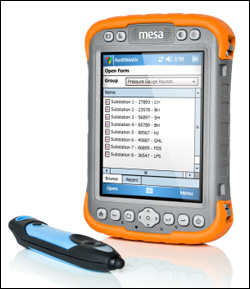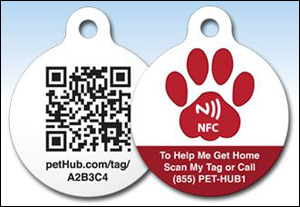The following are news announcements made during the past week.
Fujitsu Markets RFID Solution for Aircraft Parts Suppliers
Fujitsu has announced a new turnkey solution—built on the original, RFID-enabled automatic-identification technology (AIT) system that it developed with Boeing—that is designed to help aircraft parts suppliers mark, track and manage the lifecycles of the components they supply to the aircraft industry. In December 2010, Fujitsu partnered with Boeing to develop the original turnkey AIT solution, designed to enable aircraft manufacturers to manage aircraft parts through their repair, maintenance and inspection processes once they’ve been installed on planes (see Boeing, Fujitsu to Offer Airlines a Holistic RFID Solution). Boeing launched its RFID program based on that solution in February 2012 (see Boeing to Launch RFID Program for Airlines in February). The new AIT solution is designed for aircraft parts suppliers, according to Fujitsu spokesperson Bryan Hollar, and focuses on parts marking and parts lifecycle management rather than on aircraft maintenance operations. The solution enables parts suppliers to write and read their parts information (such as their birth record or serial number) onto EPC Gen 2 passive UHF tags, in compliance with the Air Transport Association‘s ATA Spec 2000 standard for RFID tagging. Fujitsu offers high-memory tags (8 or 64 kilobytes) and low-memory tags (512 bits or 2 kilobits). The solution includes Motorola‘s MC9190-Z industrial handheld interrogator and FX7400 fixed reader. The MC9190-Z will ship with pre-installed Fujitsu AIT middleware and the Utility Tool for Parts Suppliers software, Hollar reports. By affixing tags to parts during the manufacturing process, aircraft parts suppliers can capture data regarding components, such as their manufacture date, configuration and maintenance service records, using the standards-compliant format demanded by the industry. This, according to Fujitsu, makes it possible to accurately trace a part’s lifecycle from manufacture to maintenance. In addition to providing the hardware and software (including RFID tags, reader, middleware and other products), Fujitsu also provides application development, systems integration and deployment services. Moreover, while parts information can be stored directly on the tag (which means the parts can be accurately managed even if they travel between multiple owners, or when no network is present), the solution also enables the parts information to be stored and accessed in a cloud environment, so it can be integrated and analyzed along with information about parts warehousing and deliveries. This, the company reports, contributes to optimal inventory deployment and a more efficient global supply chain.
Juniper Systems Rugged Handheld Computers Bundled With IDBlue RFID Reader
Juniper Systems, a manufacturer of rugged handheld computers, has announced a partnership with IDBlue, a provider of ultra-mobile high-frequency (HF) and ultrahigh-frequency (UHF) RFID Bluetooth readers for the smartphone and tablet market. The partnership will allow Juniper Systems to provide the IDBlue RFID reader as part of a bundled package, or as a separate product, which can be used with any Bluetooth-equipped Juniper Systems rugged handheld computer. The IDBlue RFID reader is a pen-shaped device that can fit into a pocket. The reader is available in both HF and UHF versions, Juniper Systems reports, and has a pending Class I, Division 2 certification for hazardous locations. Combining the reader with Juniper Systems’ rugged handhelds enables data collection within rugged environments, the company adds. Juniper Systems and IDBlue will showcase their products at the RFID Journal LIVE! 2013 conference and exhibition, to be held from Apr. 30 to May 2, in Orlando, Fla. Juniper Systems is now accepting orders for the IDBlue reader.
U.K. University Develops NFC and Mobile Phone App for Real-Estate Market
Academics from the School of Computing and Mathematics at Plymouth University, in the United Kingdom, have developed a mobile phone application for the real-estate market that leverages Near Field Communication (NFC). The app is designed to provide prospective homebuyers with detailed information regarding the houses they are interested in buying. The idea behind the app was to make it possible for homebuyers to casually view properties from outside, prior to making an appointment, according to Martin Tomlinson, the Communications chair at the university’s School of Computing and Mathematics, and a professor in the Science and Technology department’s faculty. “Some people select the neighborhood first and walk around to see what is available for sale,” he says. The app also enables sellers to more discreetly advertise their home, its features and the price from the home site, without having to use large signs or pamphlets. The academic team—which included Tomlinson and professors Mohammed Zaki Ahmed and Marcel Ambroze—developed an encryption engine that encrypts the data stored on the tag, as well as associated apps that work with the NFC tags. The encryption engine was developed in conjunction with SRD Wireless Ltd. (more information is available here). “The significance for the NFC tags is the semantic security,” Tomlinson explains. “Semantic security provides nontraceability of tags [apart from tag ID], stopping an eavesdropper being able to associate a tag’s data with its function.” The tag ID, he adds, can be included as part of the encryption key, thereby limiting cloneability. “Cloned tags do not decrypt,” he states. The tags—which are made with NXP Semiconductors‘ NTAG203 chip, compliant with the NFC Forum Type 2 standard and offering 144 bytes of user memory—can be affixed to any structure at or near the property’s entrance. According to the university, prospective buyers can simply touch the tag with their smartphones or tablets, granting them immediate access to the full particulars of the property. Tomlinson says the encryption engine provides authentication and exclusivity, as well as measures to prevent cloning. In order to utilize the app and access information, customers must register online. The NFC Homes app can easily be installed on a smartphone or an Android tablet; running the app enables any standard NFC tag to be easily written with the encrypted data. A touch of the tag results in the app being automatically launched, reading the tag data and displaying that information on the screen. According to Tomlinson, there are other apps that could leverage the encryption engine and NFC tags, including those for the authentication of goods and business cards.
BlinkSight, Imec Unveil Single-Chip Solution for RTLS and WSN Applications
BlinkSight, a fabless semiconductor company specializing in real-time location system (RTLS) technology, has announced that it has developed a single-chip solution for RTLS and wireless sensor network (WSN) applications. The new chip is based on ultra-low-power impulse radio (IR) technology from imec, a research organization and developer in nanoelectronics, and Holst Centre, an independent research and development facility set up by imec and TNO to develop generic technologies for wireless autonomous sensor technologies and flexible electronics. Impulse radio is a form of ultra-wideband (UWB) spread-spectrum signaling, in which the RF transmissions consist of ultra-short pulses. According to BlinkSight, the chip is designed to deliver real-time information for tracking and tracing individuals and objects within indoor environments. The solution uses the ultra-low power IR, which enables real-time 3D location information that, according to the company, is accurate to within 10 centimeters (3.9 inches). The device combines digital-processing elements and sophisticated analog radio functionality on a single chip, and can operate within both the 3.1 to 4.8 GHz and 6 to 10 GHz frequency bands for use worldwide. It has an operating voltage range of 1.5 to 3.6 volts, which BlinkSight says makes it suitable for battery-powered applications. The chip can be integrated into tags, wireless sensors, base stations and mobile devices; a base station equipped with the technology could track and trace thousands of fast-moving tags in real time, the company reports. The expected read range would at least 60 meters (197 feet) when the tag and reader are within line of sight of each other, and 20 meters (66 feet) with no line of sight. In addition, BlinkSight notes, the tags would be interactive and capable of transmitting dynamic data, such as temperature readings. “Our solution is easy to install and thanks to the collaboration with imec we’ve been able to bring a working solution to market very fast,” said Stéphane Mutz, BlinkSight’s CEO and founder, in a prepared statement. “A lot of effort went into minimizing power consumption, and we expect to have tags powered by energy harvesting available soon. We aim to bring a complete turnkey system to market and want to work with industry leaders to bring accurate indoor GPS capabilities to connected devices.”
PetHub Adds NFC Technology to Pet ID Tags
PetHub, the manufacturer of the PetHub pet ID tag and services that enables dog identification via QR codes (visual 2-D bar code tags), has announced that the tag now supports Near Field Communication (NFC). PetHub decided to add NFC capability, according to company spokeswoman Michele Mehl, because—like QR codes—it offers yet another way to quickly scan a pet’s ID tag, eliminating the need for a pet to stand still in order for a person to read the text printed on the ID tag. Current PetHub ID tags are already printed with a unique QR code, Web address and toll-free telephone number. Now, the company reports, any of the four capabilities—NFC, QR code, Web address or phone number—can be used to immediately access a pet’s data, including multiple emergency contact phone numbers, critical medications, license and rabies vaccination information, microchip number, pet medical insurance status, and more. The NFC tags used in the ID tags have been tested with NFC-capable phones currently on the market, but the company declines to name the exact model of NFC inlay involved. “I left Microsoft to start PetHub because this problem can be fixed today with technology we all possess,” said Tom Arnold, PetHub’s founder and CEO, in a prepared statement. “We all have cell phones and over 60 percent of us have smartphones equipped with cameras, GPS, Web browsers, and more. Our tags provide a lifeline to anyone with a phone to an animal’s critical data to keep it safe. Priced at $19.95 MSRP, the new NFC tags are slated to officially go on sale on Apr. 14, during National Pet ID Week. Until that date, however, the tags are available for pre-order at PetHub.com/NFC at a special discounted price.



